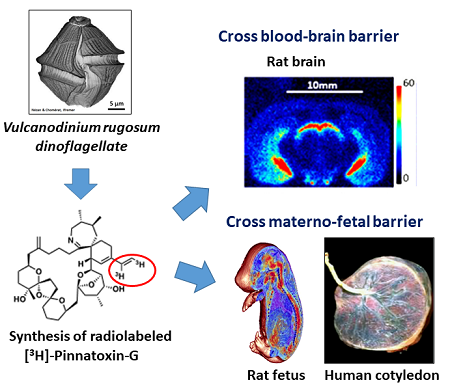The strong local proliferation of certain microalgae can cause a spectacular coloration of the water (event due to a sudden elevation of the concentration of pigments contained in the phytoplankton), detectable by satellite.This phenomenon of algal bloom depends in particular on the water temperature. Its current amplification on a large scale is a dramatic reflection of global warming and is proving to be harmful. In most cases, the species that proliferate are dinoflagellates, some of which are capable of producing toxins (known as phycotoxins) that are paralyzing, neurotoxic, amnesiac, diarrheic, or hemolytic. These toxins generally accumulate in the trophic chain and can be responsible for intoxications in humans due to the consumption of seafood.
Among the phycotoxins likely to constitute a health risk, are the pinnatoxins (PnTx) (A-H), an emerging family of lipophilic toxins, belonging to the group of cyclic imines. For the moment, no correlation between PnTx intoxication and neurotoxic effects has been reported, which explains why this family of phycotoxins is not yet regulated. However, the increase of their concentration in shellfish filtering seawater for consumption has led the ANSES to conduct a recent study setting a contamination threshold not to be exceeded (ANSES report 2019).
PnTx cause acute neurotoxic effects in mice when ingested in high doses and have a potent antagonistic effect on nicotinic acetylcholine receptors (nAChR). In order to better characterize and evaluate the potential effects of PnTx intoxication, SIMoS researchers, in collaboration with teams from the Paris Faculty of Pharmacy, MIRCen and the University of California (UCSD), studied in vivo the ability of PnTx-G, produced by the dinoflagellate Vulcanodinium rugosum, to cross physiological barriers. Tritium-radiolabeled PnTx-G was synthesized with good radiochemical purity and high yield while maintaining the high affinity of the natural toxin. Oral or intravenous administration to adult rats was followed by digital counting and autoradiography analyses, performed after exposure of the animals to the labeled toxin, in order to follow its bio-distribution and toxicokinetics. [3H]-PnTx-G is rapidly eliminated from the blood and accumulates in the liver and small intestine. Labeling of peripheral and brain tissues of adult rats and embryos demonstrated its ability to cross the intestinal, blood-brain and placental barriers. High-resolution 3D imaging and in vitro competition studies on rat embryo sections revealed the binding specificity of [3H]-PnTx-G and its selectivity for muscle and neuronal nAChR subtypes, such as the α7 subtype. The ability of PnTx-G to cross the placental barrier was also shown by quantitative mass spectrometry in an ex vivo perfused human cotyledon model.

Graphical Abstract Servent et al., Science of The Total Environment (2021), 790, 148125
These results, published in Science of the Total Environment, show for the first time the passage of PnTx-G from Vulcanodinium rugosum across the intestinal, blood-brain and placental barriers. They raise many questions about the mechanisms by which PnTx target the nervous system and impact the musculoskeletal system. In the face of global warming, it is urgent to pursue these eco-toxicological studies in order to better understand the potential risk associated with the consumption of PnTx-G contaminated shellfish on human health.
Contact : denis.servent@cea.fr